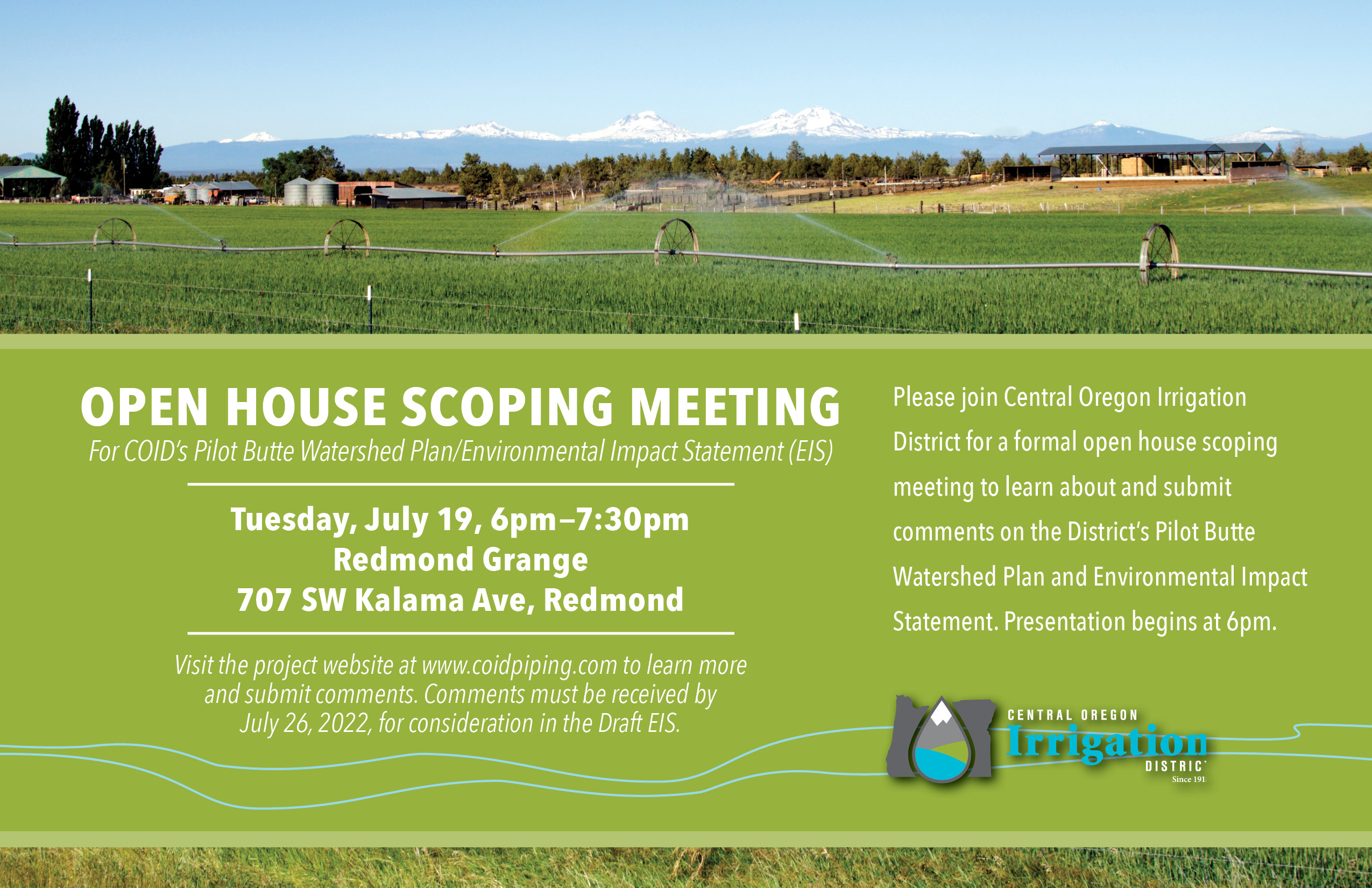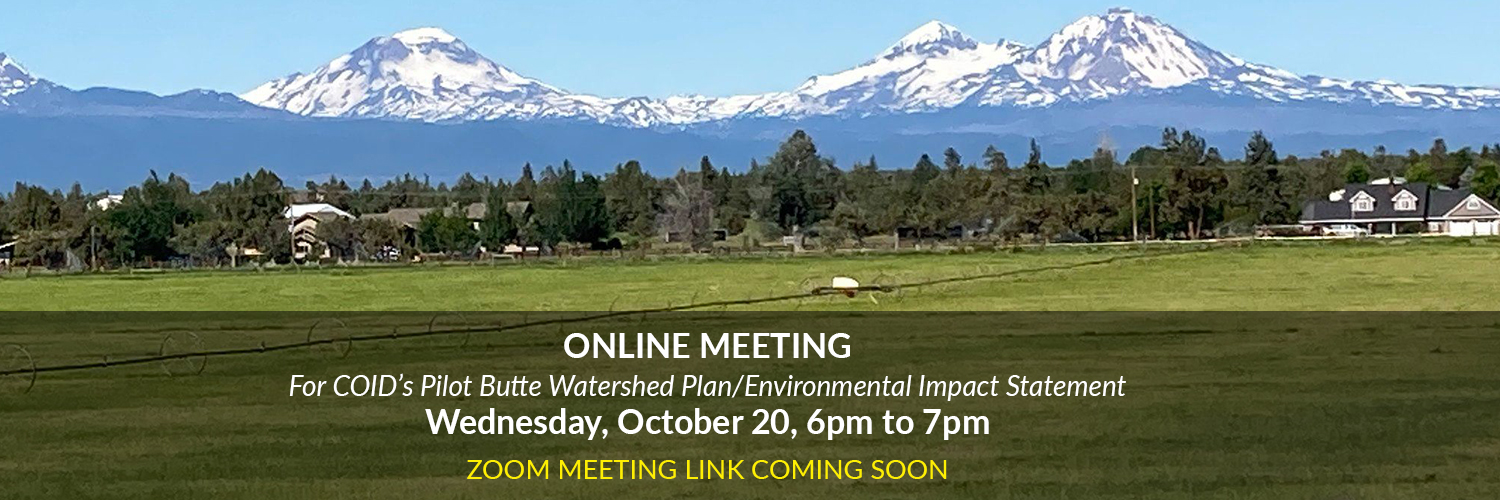Pilot Butte Canal Watershed Plan & Environmental Impact Statement
HOW TO GET INVOLVED
Submitting comments is the most effective way to make your voice heard in the EIS process. Please feel free to send comments at any time during the process.
Comments may be:
- Emailed to EisComments@coid.org
- Submitted online at Central Oregon Irrigation District – COID Piping
- Submitted via phone to (541) 699-4415
- Mailed to: Central Oregon Irrigation District, 1055 SW Lake CT, Redmond, OR 97756
YOU ARE INVITED
The Natural Resources Conservation Service (NRCS) Oregon State Office announces its intent to prepare an EIS for the Central Oregon Irrigation District (COID) Pilot Butte Canal (PBC) Project in the proximity of Redmond and Bend.
The EIS process will examine three alignment alternatives for replacing the existing PBC with a piped and pressurized system. The purpose of the new system is to promote irrigation water conservation on approximately 21 miles of COID-owned infrastructure, improve water delivery reliability to COID patrons, and reduce long-term operation and maintenance costs.
NRCS is requesting comments to identify significant issues and potential alternatives, information, and analyses relevant to the proposed action from all interested individuals, Tribes, and Federal, State and local agencies and jurisdictions.
The need for watershed planning is established and implementation of management actions are authorized under Public Law 83-566, the Watershed Protection and Flood Prevention Act of 1954, as amended, and Public Law 78-534, the Flood Control Act of 1944.
The public meeting scheduled for July 19, 2022, is part of the Notice of Intent (NOI) to prepare an EIS. The NOI formal scoping period closes July 18, 2022, however with the publication of this Notice Of Availability, the closure of scoping has been extended to July 26, 2022, to accommodate the public scoping meeting on July 19, 2022, and comments received based on information provided at the meeting.
Please join Central Oregon Irrigation District for an online informal public scoping meeting for improvements being considered to the aging infrastructure of the Pilot Butte Canal System.
The online public meeting will be conducted using Zoom. You can participate in the meeting by computer, tablet, or telephone. A recording will be available here following the October 20, 2021 meeting.
AT THE ONLINE MEETING, THE PROJECT TEAM WILL:
- Describe the proposed project
- Explain the process for an Environmental Impact
- Statement and the National Environmental Policy Act
- Describe how the public can provide input and learn more about the project
- Provide the project’s purpose and need
- Present the schedule and project steps
PROJECT DESCRIPTION
Optimization of water use in the Central Oregon basin is critical to maintaining the balance of water use as societal and environmental needs continue to change over time. Modernization of the District’s conveyance system is critical to secure instream flows in the Deschutes River system and provide associated benefits to threatened and endangered species and provide operational and pressurization benefits that result from modernization.
The proposed project, located in Deschutes County, is a continuation of COID’s modernization of the main stem of Pilot Butte Canal, 25 miles from current improvements in Redmond, Oregon to its diversion in Bend, Oregon. The Pilot Butte Canal conveys water to 17,338 acres and experiences approximately 156 cfs or 50,625 acre-feet of loss due to the volcanic nature of Central Oregon’s geology.
Beginning in October 2021, crews will be conducting exploratory work to gather information about existing conditions, including the built and natural environment.
The Natural Resources Conservation Service (“NCRS”) serves as the lead Federal Agency on the Project, and federal funding is being provided through the PL-566 program. NRCS will be responsible for providing technical direction during the preparation of the EIS and related documents.
INFORMAL SCOPING MEETING PURPOSE
The Informal Scoping meeting will help start the National Environmental Policy Act (NEPA) process for an EIS.
WHAT IS AN ENVIRONMENTAL IMPACT STATEMENT (EIS)
The National Environmental Policy Act requires federal agencies to assess the environmental effects of their proposed actions prior to making decisions.
An Environmental Impact Statement (EIS) is prepared when it is anticipated that a proposed project could significantly affect the quality of the human and natural environment. Adhering to NEPA is required on any project that would receive any federal funding.
HOW TO GET INVOLVED
Submitting comments is the most effective way to make your voice heard in the EIS process. Please feel free to send comments at any time during the process.
Comments may be:
- Emailed to EisComments@coid.org
- Submitted online at Central Oregon Irrigation District – COID Piping
- Submitted via phone to (541) 699-4415
- Mailed to: Central Oregon Irrigation District, 1055 SW Lake CT, Redmond, OR 97756

